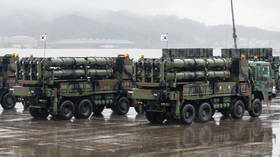Super Blood Wolf Moon: Your essential guide to rare lunar event
Stargazers are in for an epic astronomical treat this weekend, when three cosmic elements merge to create a ‘super blood wolf moon’, something that’s only going to happen three times this century.
Here’s RT’s guide to the rare lunar event.
Why all these names
A ‘wolf moon’ is the name given for a full moon that happens in January, and derives from early Native American tribes noting when wolves would allegedly howl at the moon, according to the Farmer's Almanac. A total lunar eclipse is called a ‘blood moon’, and gets its name from the tint it gets when the Earth and moon briefly line up, casting a shadow over the lunar surface.
It’s considered a ‘supermoon’ because the moon will reach its closest orbital point to Earth, making it appear 10 to 15 percent bigger than usual.
Why it’s worth seeing
In a nutshell, this is a rare enough occurence to be worth you standing outside on a blisteringly cold January night, staring up at the sky. While Earthlings can catch scores of supermoons and blood moons in their lifetime, a combination of the two taking place together in January only happens three times this century.
Also, this will be the last total lunar eclipse until May 2021, so miss this and you’ll be waiting over two years for the next one.
A Super Blood Wolf Moon Eclipse is coming to a theatre near you. On Sunday, January 20th into Monday the 21st, we’ll have a total lunar eclipse of a super blood moon (reddish tint, 14% bigger, 30% brighter). It will also be a full moon Jan 21, known as the Wolf moon. pic.twitter.com/TfCA2U4SXL
— Jared Silverman (@JaredKENS5) January 10, 2019
When to look up
The key timeframe is Sunday evening (January 20) or early Monday morning, depending on where you live in the world. The event starts at 02:36 UTC, however the part you don’t want to miss (totality) starts at 04:41 UTC and will last for about an hour. Unlike solar eclipses, you don’t need eye protection to witness this one, and if the sky above is clear, stargazers should be able to look on from cities and villages alike.

Where to watch
People in North and South America should have a particularly spectacular view of the celestial proceedings, but they will also be visible from Greenland, Iceland, parts of western Europe and parts of Western Africa. Meanwhile, eastern Europe, eastern Africa and a lucky few on the fringe of east Asia will be able to see a partial lunar eclipse.
The vast majority of Asia, and all of Australia, will not be able to see the eclipse this time, according to NASA.
If you can't catch a glimpse of the natural phenomenon in person, you can watch via online livestreams, including this one from the TimeAndDate.
Also on rt.com Moon river: Cool-looking ice disk forms in rare natural phenomenon (PHOTO,VIDEO)Like this story? Share it with a friend!














